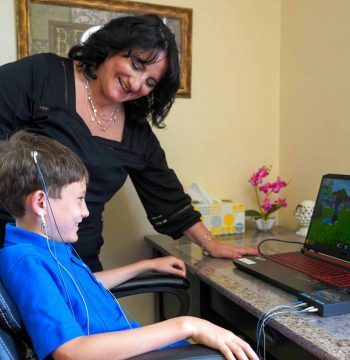Sensory processing disorders can be overwhelming for parents and children. While it can be hard to determine whether your child has a sensory processing disorder, understanding what it is and how to support your child are the first steps to building a successful home life.
Join us for a free workshop at our Ridgefield, CT office on What is Sensory Processing?: How to Support Your Child's Sensory Needs on Tuesday, March 6 – 10 am (Thursday, March 8 – 10 am snowdate backup)
What is Sensory Processing?
Sensory processing is an innate neurobiological process that refers to the way the nervous system receives messages from the senses and turns them into appropriate motor and behavioral responses. Brains integrate and interpret sensory stimulation from the environment and then transform sensory information from within the body to act on the external environment.
When the brain receives information, it gives meaning to even the smallest bits of information, which helps the nervous system react appropriately to sensory stimulation. The senses – touch, sight, sound, movement, body awareness, taste, and smell – must work together so the brain and body have predictable ways of interpreting and responding.
What is Sensory Integration?
Sensory integration is the process by which the brain receives information through the senses, organizes this information, and uses it to participate in everyday activities. Sensory integration focuses primarily on three basic senses: tactile, vestibular, and proprioceptive.
The tactile system includes nerves under the skin's surface that send information to the brain. The vestibular system refers to structures within the inner ear that detect movement and changes in the position of the head. The proprioceptive system refers to components of muscles, joints, and tendons that provide a person with a subconscious awareness of body position.
The interconnections between these systems start forming early in a child’s life continuing to develop as the person matures and interacts with their environment. These complex related systems are also connected with other systems in the nervous system so people can experience, interpret, and respond to different stimuli in their environment.
What is a Sensory Processing Disorder?
Children with Sensory Processing Disorder (SPD) experience difficulty receiving and responding to information that is obtained through the senses. When an individual’s nervous system is not able to appropriately turn sensory messages into correlating actions or behaviors, they likely suffer from SPD. Since sensory input is not integrated or organized appropriately in the brain and may produce varying degrees of problems in development, information processing, and behavior.
What is Sensory Processing Disorder in Children?
A child with SPD may find it difficult to process and act upon information received through the senses. Their senses – auditory, visual, vestibular, tactile, olfactory, gustatory, and proprioception – can be impacted in some way. Children with sensory processing issues may be oversensitive or undersensitive to the world around them because they are unable to modulate the everyday sensory information they receive through their senses. A child with SPD may have one or more systems impacted, as well as one or more sensory sensitivities.
Their nervous systems feel specific sensation too easily or too intensely. Some children try to avoid certain sensory experiences, while others may actually seek them out. Often, children with sensory processing issues have issues with motor skills and motor planning as a result. This creates challenges in performing countless everyday tasks. Children with sensory processing issues can be oversensitive to sights, sounds, textures, flavors, smells and other sensory input. For example, they may avoid and be overly reactive certain clothing or food textures. The simple task of getting dressed may be overwhelming for a child with SPD and lead to tears and meltdowns because their system is overloaded, which causes anxiety or uncomfortable feelings. They respond with behaviors because they aren’t able to connect those feelings with their body.
What are Sensory Processing Disorder Symptoms?
While everyone can experience occasional difficulties with appropriately processing information received by the senses, for people with sensory processing integration disorder, such difficulties are chronic and cause disruptions in many aspects of their daily lives.
- Hyperacute or hypersensitive hearing
- Extreme response to or fear of sudden, high-pitched, loud, or metallic noises
- Resistant to food textures
- Awareness of and/or distracted by background noises that others don’t seem to hear
- Difficulty distinguishing between similar sounds
- Fearful of surprise touch causing avoidance of hugs and cuddling even with familiar adults
- Difficulty manipulating an object when out of sight
- Difficulties following directions
- Problems finding an image in a cluttered background
- Difficulty isolating head-eye movements
- Poor tracking of visual stimuli
- Clumsy and uncoordinated movements
- Accident-prone
- Poor sense of movement speed
- Poor posture control or strength
- Poor equilibrium and balance
- Avoidance of upper extremity weight bearing
- Discomfort climbing or fear of heights
- Tires easily
- Challenges establishing dominant hand (right or left handedness)
- Poor fine motor coordination
- Trouble performing activities of daily living
- Resistant to new activities
- High tolerance for or indifference to pain
- Poor playing skills
- Lacks understanding of personal space even when same-age peers are old enough to understand it
- Constant need to touch people or textures
- Using too much or too little force
- Accidentally harming other children and/or pets when playing, i.e. doesn't understand his or her own strength
- Overly aggressive
- Tendency to to fidget and inability to sit still
- Lack understanding of boundaries
- Appearance as “thrill seeker”, which can be dangerous at times
- Sensitivity to clothes and fabric textures
What Disorders Co-occur with SPD?
Sensory processing disorder may occur with other types of disorders. The most common co-occurring disorders include:
- Autism Spectrum Disorder
- Attention-Deficit Hyperactivity Disorder
- Fragile X syndrome
- Infection-Induced Neurocognitive and Psychiatric Issues (PANS/PANDAS, Lyme, etc)
- Language disorders and speech delays
- Learning disabilities
- Post-Traumatic Stress Disorder
What Causes Sensory Processing Disorder?
While no large scale study has been done to identify the specific cause of SPD,practitioners know that SPD co-occurs with several disorders arising out of genetic and environmental causes.
These children also have a higher rate of birth trauma, jaundice, feeding issues, and sleep difficulties. From a brain perspective, research demonstrates that in specific sensory regions of the brain, kids with sensory processing disorder have decreased structural brain connectivity.
What Skills are Affected by Sensory Processing Issues?
Everyone can experience occasional difficulties with appropriately processing information received by the senses. For people with sensory processing integration disorder, such difficulties are chronic and cause disruptions in many aspects of their daily lives. Kids with sensory processing issues often struggle to adjust to new surroundings, experiences, and situations. These children are more likely to experience a variety of issues that impact them at home and school.
- Rigidity and resistance to change
- Difficulty transitioning
- Trouble focusing
- Impulsivity
- Executive functioning deficits
- Delayed motor skills
- Poor social skills
- Weak problem solving
- Poor self-control and self-regulation
How Do Sensory Processing Issues Impact Kids at School?
While a sensory processing dysfunction is not a learning disability, it can make it hard for children to succeed at school by interfering with cognitive, attentional, behavioral, social, and emotional functioning.
Simple things that other kids can tolerate can cause a sensory overload for a kid with SPD. Kids with SPD can struggle with their emotional and with behavioral control thus interfering with social functioning. Kids with SPD often struggle with attention and behavior at school because of the increased sensory demands.
Due to their difficulties modulating sensory information, kids can struggle with attention and executive functioning and learning which leads to difficulties reading or working on seatwork. They often appear inattentive and are often incorrectly identified as having ADHD. If the lights or noise bother them, they might forget about “Criss Cross Applesauce”.
How Do Sensory Processing Issues Impact Kids at Home?
For the child with SPD, the same behaviors that occur at school can occur at home. In some cases, the behavior is worse, as they have “held it together” all day at school and in other cases kids are better in the less stimulating home environment.
Most of the time, however, kids with SPD struggle both at home and school. Their difficulties with sensory processing can make following directions, getting along with siblings, getting dressed, eating, paying attention, and a long list of other everyday activities very hard. Without the appropriate sensory stimulation, increased behaviors and emotionality become the norm. The good news is there are things that parents can do to support children at home.
How is Sensory Processing Disorder Diagnosed?
According to the Sensory Processing Disorder Foundation, at least one in every 20 children is affected by SPD making it a relatively common childhood disorder. Children with SPD are most likely diagnosed after a clinical intake or testing with a Occupational Therapist, Psychologist or Physician.
While no a medical diagnosis for SPD exists, parents commonly complete behavioral rating inventories after a detailed intake. In some instances, one to one testing or physical testing is administered. Most children with SPD are typically identified between the ages of three and ten.
How is Sensory Processing Disorder Different from Autism?
Just because a child is diagnosed with SPD, doesn’t mean they also have Autism. Almost every child with Autism, however, does have sensory processing issues.
They do have some common symptoms. Children with either SPD or Autism often have meltdowns, unusual eating habits, mood issues, and over-emotional reactions.
Autism is a developmental disorder where children have significant social, communication, and behavioral challenges. Children with Autism display restricted interests and unusual repetitive behaviors. Most importantly, children with Autism have significant difficulties in the social realm due to difficulties understanding body language and facial expressions, inferencing and perspective taking and with social communication and play in general.
How is Sensory Processing Disorder Different from ADHD?
Many children with SPD have trouble focusing. With SPD, difficulty focusing arises from the nervous system's inability to modulate the information it is receiving.
ADHD is a neurobiological disorder that has genetic causes. With ADHD, the brain is unable to self-regulate impulses and cognitive functioning. The two disorders have more behavioral similarities than differences but are two distinct disorders.
What resources and treatment can help with SPD?
Occupational therapy provides hope for kids handling the visual, tactile, and auditory difficulties that SPD creates. Parents and educators need information to further SPD children’s development at home and at school. A plan that supports sensory needs, also called a sensory diet, can help make everyone’s life easier. For example, offering a child with SPD a quiet room where they can calm down may be one accommodation.
Pediatric occupational therapists can guide children with helpful tools such as coping mechanisms and calming strategies so they can lead happy, healthy lives which leads to a stronger family unit.
To learn more about therapies for Sensory Processing Disorder, read my blog.
To make an appointment with Dr. Roseann or one of our clinicians 203.438.4848 or email [email protected].
Dr. Roseann is a Psychologist who works with children, adults, and families from all over the US, supporting them with research-based and holistic therapies that are bridged with neuroscience. Dr. Roseann is a Board Certified Neurofeedback (BCN) Practitioner, Certified Integrative Medicine Mental Health Provider (CMHIMP) and is a Board Member of the Northeast Region Biofeedback Society (NRBS) and Epidemic Answers. She is also a member of the American Psychological Association (APA), National Association of School Psychologists (NASP), Connecticut Counseling Association (CCA), International OCD Foundation (IOCDF) International Society for Neurofeedback and Research (ISNR) and The Association of Applied Psychophysiology and Biofeedback (AAPB).
©Roseann-Capanna-Hodge, LLC 2019
Always remember… “Calm Brain, Happy Family™”
Are you looking for SOLUTIONS for your struggling child or teen?
Dr. Roseann and her team are all about solutions, so you are in the right place!
There are 3 ways to work with Dr. Roseann:
You can get her books for parents and professionals, including: It’s Gonna Be OK™: Proven Ways to Improve Your Child’s Mental Health, Teletherapy Toolkit™ and Brain Under Attack: A Resource For Parents and Caregivers of Children With PANS, PANDAS, and Autoimmune Encephalopathy.
If you are a business or organization that needs proactive guidance to support employee mental health or an organization looking for a brand representative, check out Dr. Roseann’s media page and professional speaking page to see how we can work together.
Dr. Roseann is a Children’s Mental Health Expert and Therapist who has been featured in/on hundreds of media outlets including, CBS, NBC, FOX News, PIX11 NYC, The New York Times, The Washington Post,, Business Insider, USA Today, CNET, Marth Stewart, and PARENTS. FORBES called her, “A thought leader in children’s mental health.”

She is the founder and director of The Global Institute of Children’s Mental Health and Dr. Roseann Capanna-Hodge. Dr. Roseann is a Board Certified Neurofeedback (BCN) Practitioner, a Board Member of the Northeast Region Biofeedback Society (NRBS), Certified Integrative Medicine Mental Health Provider (CMHIMP) and an Amen Clinic Certified Brain Health Coach. She is also a member of The International Lyme Disease and Associated Disease Society (ILADS), The American Psychological Association (APA), Anxiety and Depression Association of America (ADAA) National Association of School Psychologists (NASP), International OCD Foundation (IOCDF) International Society for Neurofeedback and Research (ISNR) and The Association of Applied Psychophysiology and Biofeedback (AAPB).
© Roseann-Capanna-Hodge, LLC 2023
Disclaimer: This article is not intended to give health advice and it is recommended to consult with a physician before beginning any new wellness regime. *The effectiveness of diagnosis and treatment vary by patient and condition. Dr. Roseann Capanna-Hodge, LLC does not guarantee certain results.













